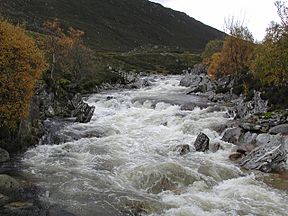River Avon, Strathspey facts for kids
Quick facts for kids River Avon |
|
|---|---|

The "Linn of Avon" in Glen Avon
|
|
| Native name | Abhainn Athfhinn |
| Country | United Kingdom, Scotland |
| Region | Moray |
| Physical characteristics | |
| Main source | Loch Avon, Moray |
| River mouth | Glenlivet, Moray |
| Length | 30 km (19 mi) |
The River Avon (pronounced "Aan" by local people) is a river in the Scottish Highlands. It flows through the beautiful Strathspey area. This river is a tributary, meaning it flows into a larger river, which in this case is the River Spey.
The River Avon helps drain the north-eastern part of the Cairngorm Mountains. Most of the river is located inside the Cairngorms National Park.
Contents
Journey of the River Avon
Where Does It Start?
The River Avon is said to begin at Loch Avon. This loch (Scottish word for lake) is found between two large mountains, Cairn Gorm and Ben Macdui. Loch Avon itself gathers water from many small streams that flow down these mountains.
From Loch Avon, the river flows east through Glen Avon. It travels for about 10 miles (16 km) before turning north. It then heads towards the village of Tomintoul and an area called Strath Avon.
Other Streams Joining In
As the River Avon flows, many smaller streams join it. These are called tributaries.
In the first few miles, the river goes through the Forest of Glenavon. Here, streams like the Burn of Loin and the Builg Burn add their water. The Builg Burn starts at Loch Builg and joins the Avon near a spot called the Linn of Avon.
Closer to Tomintoul, the Water of Ailnack flows into the Avon. This stream comes from a very deep, narrow valley. Further downstream from Tomintoul, two more streams join: the Conglass Water from the east and the Burn of Lochy from the west. The Burn of Lochy is also fed by the Burn of Brown.
The last major stream to join the River Avon is the River Livet. It flows from Glenlivet and meets the Avon at Drumin. This is just as the River Avon leaves the national park.
Fishing and Tourism
There is a group called the River Avon Fishing Association. This group helps promote fishing along the river. They also encourage people to visit the nearby towns, which helps local tourism.
What's in a Name?
The name Avon is very old and means 'river' or 'stream'. It comes from the Gaelic word abhainn. You might notice that many rivers in Scotland and Wales have similar names, like the Welsh word afon. This is because the word comes from a very ancient language root.

